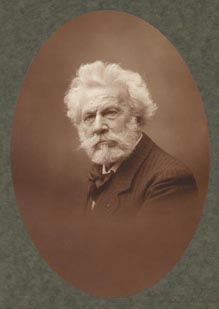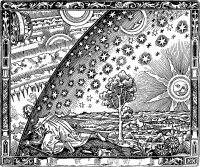Nicolas Camille Flammarion
Nicolas Camille Flammarion (February 26, 1842 - June 3, 1925) was a French astronomer, prolific author of more than fifty titles and member of the Theosophical Society. His writings include popular science works about astronomy, several notable early science fiction novels, and works on psychical research and related topics. He also published the magazine L'Astronomie, starting in 1882. He maintained a private observatory at Juvisy-sur-Orge, France.
Biography
Camille Flammarion was born in Montigny-le-Roi, Haute-Marne, France. He was the brother of Ernest Flammarion (1846–1936), founder of the Groupe Flammarion publishing house. He was a founder and the first president of the Société Astronomique de France, which originally had its own independent journal, BSAF (Bulletin de la Société Astronomique de France), first published in 1887. His first wife was Sylvie Petiaux-Hugo Flammarion, and his second wife was Gabrielle Renaudot Flammarion, also a noted astronomer.
Flammarion died at Juvisy Observatory, Paris, on June 3, 1925.
Theosophical involvement
Flammarion was a member of the General Council of the Theosophical Society in 1880.[1]
He was mentioned by Master K.H. in Mahatma Letter No. 67:
You have among the learned members of your society one Theosophist who without familiarity with our occult doctrine, has yet intuitively grasped from scientific data the idea of a solar pralaya and its manwantara in their beginnings. I mean the celebrated French astronomer Flammarion — "La Resurrection et la Fin des Mondes" (Chapter 4 res.). He speaks like a true seer. The facts are as he surmises with slight modifications.[2]
In the eleventh chapter of Esoteric Buddhism called "The Universe", A. P. Sinnett includes Flammarion's ideas about a planet reaching the end of its life:
The French astronomer Flammarion, in a book called La Résurrection et la Fin des Mondes, has approached a conception of this ultimate materiality. The facts are, I am informed, with slight modifications, much as he surmises. In consequence of what he treats as secular refrigeration, but which more truly is old age and loss of vital power, the solidification and desiccation of the earth at last reaches a point when the whole globe becomes a relaxed conglomerate. Its period of child-bearing has gone by; its progeny are all nurtured; its term of life is finished. Hence its constituent masses cease to obey those laws of cohesion and aggregation which held them together. And becoming like a corpse, which, abandoned to the work of destruction, leaves each molecule composing it free to separate itself from the body, and obey in future the sway of new influences, "the attraction of the moon,” suggests M. Flammarion, "would itself undertake the task of demolition by producing a tidal wave of earth particles instead of an aqueous tide." This last idea must not be regarded as countenanced by occult science except so far as it may serve to illustrate the loss of molecular cohesion in the material of the earth.[3]
H. P. Blavatsky also held Flammarion in esteem with respect to contemporary Science. In The Secret Doctrine she wrote:
Even the question of the plurality of worlds inhabited by sentient creatures is rejected or approached with the greatest caution! And yet see what the great astronomer, Camille Flammarion, says in his Pluralité des mondes.[4]
About the Aryan Root-Race and its origins, Science knows as little as of the men from other planets. With the exception of Flammarion and a few mystics among astronomers, even the habitableness of other planets is mostly denied. Yet such great adept astronomers were the Scientists of the earliest races of the Aryan stock, that they seem to have known far more about the races of Mars and Venus than the modern Anthropologist knows of those of the early stages of the Earth.[5]
Mme Blavatsky also commented on Flammarion's scientific arguments that the conditions necessary for life are present on other planets:
Still the fact remains that most of the planets, as the stars beyond our system, are inhabited, a fact which has been admitted by the men of science themselves. Laplace and Herschell believed it, though they wisely abstained from imprudent speculation; and the same conclusion has been worked out and supported with an array of scientific considerations by C. Flammarion, the well-known French Astronomer. The arguments he brings forward are strictly scientific, and such as to appeal even to a materialistic mind, which would remain unmoved by such thoughts as those of Sir David Brewster.[6]
. . . Flammarion shows, in addition, that all the conditions of life — even as we know it — are present on some at least of the planets, and points to the fact that these conditions must be much more favourable on them than they are on our Earth.
Thus scientific reasoning, as well as observed facts, concur with the statements of the seer and the innate voice in man’s own heart in declaring that life — intelligent, conscious life — must exist on other worlds than ours.
But this is the limit beyond which the ordinary faculties of man cannot carry him. Many are the romances and tales, some purely fanciful, others bristling with scientific knowledge, which have attempted to imagine and describe life on other globes. But one and all, they give but some distorted copy of the drama of life around us. It is either, with Voltaire, the men of our own race under a microscope, or, with de Bergerac, a graceful play of fancy and satire; but we always find that at bottom the new world is but the one we ourselves live in. So strong is this tendency that even great natural, though non-initiated seers, when untrained, fall a victim to it; witness Swedenborg, who goes so far as to dress the inhabitants of Mercury, whom he meets with in the spirit-world, in clothes such as are worn in Europe.
Commenting on this tendency Flammarion said:
- “It seems as if in the eyes of those authors who have written on this subject, the Earth were the type of the Universe, and the Man of Earth, the type of the inhabitants of the heavens. It is, on the contrary, much more probable, that, since the nature of other planets is essentially varied, and the surroundings and conditions of existence essentially different, while the forces which preside over the creation of beings and the substances which enter into their mutual constitution are essentially distinct, it would follow that our mode of existence cannot be regarded as in any way applicable to other globes.Those who have written on this subject have allowed themselves to be dominated by terrestrial ideas, and fell therefore into error.” (La pluralité des mondes habités, p. 439-440.)
But Flammarion himself falls into the very error which he here condemns, for he tacitly takes the conditions of life on earth as the standard by which to determine the degree to which other planets are adapted for habitation by “other Humanities.” [7]
The Flammarion Engraving
The "Flammarion engraving" first appeared in Flammarion’s 1888 edition of L’Atmosphère. In 1907, he wrote that he believed that dwellers on Mars had tried to communicate with the Earth in the past.
Online resources
- Camille Flammarion at Wikipedia, the free encyclopedia.
- Camille Flammarion at Wikisource.
- Nicolas Camille at Theosophy World.
References
- ↑ "The Theosophical Society," The Theosophist 1.8 (May, 1880), 214.
- ↑ Vicente Hao Chin, Jr., The Mahatma Letters to A.P. Sinnett in chronological sequence No. 67 (Quezon City: Theosophical Publishing House, 1993), 188.
- ↑ Sinnett, A.P. Esoteric Buddhism (Wheaton, IL: Theosophical Publishing House, 1972), 153.
- ↑ Helena Petrovna Blavatsky, The Secret Doctrine Vol. I (Wheaton, IL: Theosophical Publishing House, 1993), footnote, 606.
- ↑ Blavatsky, H.P. The Secret Doctrine Vol. 2 (Wheaton, IL: Theosophical Publishing House. 1993) 698-699.
- ↑ Sir David Brewster (11 December 1781 – 10 February 1868) was a Scottish physicist, mathematician, astronomer, inventor, writer, historian of science and university principal.
- ↑ Blavatsky, H.P. The Secret Doctrine Vol. 2 (Wheaton, IL: Theosophical Publishing House. 1993) 701-703.

